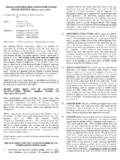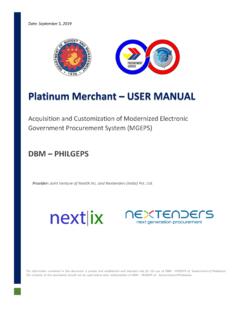Transcription of MT-015: Basic DAC Architectures II: Binary DACs
1 MT-015 TUTORIAL Basic DAC Architectures II: Binary DACs by Walt Kester INTRODUCTION While the string DAC and thermometer DAC Architectures are by far the simplest, they are certainly not the most efficient when high resolutions are required. Binary -weighted DACs utilize one switch per bit and were first developed in the 1920s (see References 1, 2, and 3). Since then, the architecture has remained popular and forms the backbone for modern precision as well as high-speed DACs. Binary -WEIGHTED DACS The voltage-mode Binary -weighted resistor DAC shown in Figure 1 is usually the simplest textbook example of a DAC.
2 However, this DAC is not inherently monotonic and is actually quite hard to manufacture successfully at high resolutions. In addition, the output impedance of the voltage-mode Binary DAC changes with the input code. R/8R/4R/2 RVVREFOUTMSBLSBA dapted from: B. D. Smith, "Coding by Feedback Methods," Proceedings of the I. R. E., Vol. 41, August 1953, pp. 1053-1058 Figure 1: Voltage-mode Binary -Weighted Resistor DAC Current-mode Binary DACs are shown in Figure 2A (resistor-based), and Figure 2B (current-source based). An N-bit DAC of this type consists of N weighted current sources (which may simply be resistors and a voltage reference) in the ratio 1:2:4:8.
3 :2N 1. The LSB switches the 2N 1 current, the MSB the 1 current, etc. The theory is simple but the practical problems of manufacturing an IC of an economical size with current or resistor ratios of even 128:1 for an 8-bit DAC are significant, especially as they must have matched temperature coefficients. , 10/08, WK Page 1 of 10 MT-015 DIFFICULT TO FABRICATE IN ICFORM DUE TO LARGE RESISTOR OR CURRENT RATIOS FOR HIGH RESOLUTIONSVREFMSBLSBR2R4R8 RVREFMSBLSBR2R4R8 RCURRENT OUTPUTSINTO VIRTUAL GROUNDS(A) RESISTOR(B) CURRENT SOURCETI/2I/4I/8 LSBMSBI Figure 2: Current-Mode Binary -Weighted DACs If the MSB current is slightly low in value, it will be less than the sum of all the other bit currents, and the DAC will not be monotonic (the differential non-linearity of most types of DACs is worst at major bit transitions).
4 This architecture is virtually never used on its own in integrated circuit DACs, although, again, 3- or 4-bit versions have been used as components in more complex structures. However, there is another Binary -weighted DAC structure that has recently become widely used. This uses Binary -weighted capacitors as shown in Figure 3. The problem with a DAC using capacitors is that leakage causes it to lose its accuracy within a few milliseconds of being set. This may make capacitive DACs unsuitable for general purpose DAC applications , but it is not a problem in successive approximation adcs , since the conversion is complete in a few s or less long before leakage has any appreciable effect.
5 The successive approximation ADC has a very simple structure, low power, and reasonably fast conversion times. It is probably the most widely used general-purpose ADC architecture , but in the mid-1990s the subranging ADC was starting to overtake the successive approximation type in popularity because the R-2R thin-film resistor DAC in the successive approximation ADC made the chip larger and more expensive than that of a subranging ADC, even though the subranging types tend to use more power. The development of sub-micron CMOS processes made possible very small (and therefore cheap), and very accurate switched capacitor DACs.
6 These enabled a new generation of successive approximation adcs to be made small, cheap, low-power and precise, and thus to regain their popularity (such as the Analog Devices' PulSAR family, for example). Page 2 of 10 MT-015 _+_+C/ 4C/ 2CC/ 4 AINVREFSINSCS1S2S3S4 BIT1(MSB)BIT2 BIT3(LSB)SWITCHES SHOWN IN TRACK (SAMPLE) MODEAACTOTAL= 2C Figure 3: Capacitive Binary -Weighted DAC in Successive Approximation ADC The use of capacitive charge redistribution DACs offers another advantage as well the DAC itself behaves as a sample-and-hold circuit (SHA), so neither an external SHA nor allocation of chip area for a separate integral SHA are required.
7 R-2R DACs One of the most common DAC building-block structures is the R-2R resistor ladder network shown in Figure 4. It uses resistors of only two different values, and their ratio is 2:1. An N-bit DAC requires 2N resistors, and they are quite easily trimmed. There are also relatively few resistors to trim. 2R2R2R2R2 RRRR Figure 4: 4-Bit R-2R Ladder Network There are two ways in which the R-2R ladder network may be used as a DAC known respectively as the voltage mode and the current mode. They are sometimes called "normal" Page 3 of 10 MT-015mode and "inverted" mode, respectively, but as there is no consensus on whether the voltage mode or the current mode is the "normal" mode for a ladder network, so this nomenclature can be misleading.
8 Each mode has its advantages and disadvantages. In the voltage mode R-2R ladder DAC shown in Figure 5, the "rungs" or arms of the ladder are switched between VREF and ground, and the output is taken from the end of the ladder. The output may be taken as a voltage, but the output impedance is independent of code, so it may equally well be taken as a current into a virtual ground. As mentioned earlier, this architecture was proposed by B. D. Smith in 1953 (Reference 3). 2 RRRR2R2R2R2 RVVREFOUTMSBLSBA dapted from: B. D. Smith, "Coding by Feedback Methods," Proceedings of the I. R. E., Vol. 41, August 1953, pp.
9 1053-1058 Figure 5: Voltage-Mode R-2R Ladder Network DAC The voltage output is an advantage of this mode, as is the constant output impedance, which eases the stabilization of any amplifier connected to the output node. Additionally, the switches switch the arms of the ladder between a low impedance VREF connection and ground, which is also, of course, low impedance, so capacitive glitch currents tend not to flow in the load. On the other hand, the switches must operate over a wide voltage range (VREF to ground). This is difficult from a design and manufacturing viewpoint, and the reference input impedance varies widely with code, so that the reference input must be driven from a very low impedance.
10 In addition, the gain of the DAC cannot be adjusted by means of a resistor in series with the VREF terminal. In the current-mode R-2R ladder DAC shown in Figure 6, the gain of the DAC may be adjusted with a series resistor at the VREF terminal, since in the current mode, the end of the ladder, with its code-independent impedance, is used as the VREF terminal; and the ends of the arms are switched between ground (or, sometimes, an "inverted output" at ground potential) and an output line which must be held at ground potential. The normal connection of a current-mode ladder network output is to an op amp configured as current-to-voltage (I/V) converter, but stabilization of this op amp is complicated by the DAC output impedance variation with digital code.














